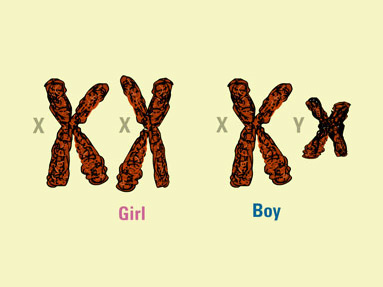DNA fingerprinting
Within our body lie millions of copies of DNA. This DNA is unique to each human being, with the possibility of two people having the same DNA code being nearly 1 in a billion! For a number of years now, this property of DNA has been exploited in criminal investigations and parental tests. DNA fingerprinting, also called genetic fingerprinting has emerged as an extremely useful technique to identify specific and unique DNA base pairs within the genetic make-up of an individual. In a nutshell, DNA fingerprinting is defined as a method of identifying an individual’s unique DNA sequence by exposing the base pairs to specific molecular probes.
We shall review DNA fingerprinting as a technique, discussing the history of its development and its uses in forensic science.
History of DNA fingerprinting
DNA fingerprinting as a technique was developed by Sir Alec Jeffreys at the University Of Leicester, United Kingdom in 1984. He started working with genes and genetic code in a small laboratory at the age of 27 yrs, and following a series of experiments stumbled across what he calls a “eureka moment”, breaking the DNA code and revealing what is now called DNA fingerprinting.
Since its discovery, its uses have expanded all the way into the crime labs as a part of forensic investigations, immigration and even paternity tests. It is also used to identify twins.
The first application of DNA fingerprinting was in immigration cases with extremely favourable and rather mindboggling results. Since then the applications have spread to different areas.
The procedure
In order to perform DNA fingerprinting, a sample is required. This sample can be a hair follicle (with the root intact), a piece of skin, nail, and a drop of blood (these are in forensic cases). For paternity tests, blood samples can be drawn from the person.
There are different ways DNA fingerprinting is conducted. Restriction Fragment Length Polymorphism (RFLP) with Southern blot is one such procedure, while polymerase chain reaction combined with short tandem repeats is another procedure.
RFLP method
The entire process of DNA fingerprinting sounds complicated, but making DNA fingerprints is in fact just a 5 step process.
Step 1 – DNA isolation from cells or tissues
The process of DNA isolation is called Southern Blotting. The procedure involves restriction fragment length polymorphism, also called RFLP DNA fingerprinting. DNA is extracted from within the cells using a detergent. Once the DNA is extracted, it is subject to cutting.
Step 2 – Cutting and sorting the DNA
By using restriction enzymes, the DNA double strand is cut into different size pieces. This is done in order to isolate certain base pairs. These bases pairs that are generated are unique to that particular individual. Following this, the pieces are separated according to their size by a process called gel electrophoresis. Simply explained, the DNA pieces are placed on a gel such as agarose gel and subject to a tiny electric current. Smaller pieces move towards to the bottom of the gel faster than the larger pieces and can therefore be isolated easily according to size.
Step 3 – Transfer to Nylon membrane
Once the pieces are isolated, a nylon membrane is placed on the gel overnight and they are transferred to the membrane.
Step 4 – Probing
Once the transfer has occurred, the nylon membrane is exposed to radioactive probes, which attach to the DNA pieces.
Step 5 – Fingerprinting
Once the probes attach, a specific pattern is obtained. This pattern is the DNA fingerprint. The possibility of this fingerprint being the same in 2 human beings is 1 in several billion. However, the DNA fingerprint can be the same in identical twins.
In the above described process, Southern blot may require a large amount of DNA for it to produce sufficient pieces for analysis. However, as one may be aware, when DNA analysis is performed for criminal investigative purposes, the amount of DNA available is small. In such cases, performing a polymerase chain reaction (PCR) can help product millions of copies of DNA in a short while.
PCR with STR
The current method of DNA fingerprinting that is performed in most placed across the world includes PCR combined with short tandem repeats (STR). These STR’s are a short sequence of DNA comprised of just a few bases which is amplified and subject to gel electrophoresis. The technique is very accurate and is the preferred method in a number of countries. Data obtained from PCR and STR is placed in DNA profiling systems and is available easily when required.
Reasons for DNA fingerprinting
DNA fingerprinting as a procedure and test has become an essential part of a criminal investigation these days. Blood samples and hair samples, along with sweat and other bodily fluids contain DNA in them, all of which are unique to that individual. But its role is not just to reach a conviction – it also helps exonerate people who have been falsely imprisoned and are innocent.
DNA fingerprinting is also used to identify a dead body at a crime scene. This is particularly useful if a body is badly decomposed and there are no other obvious external identifying features.
Other applications include ascertaining parenthood. DNA tests are used to identify the father of the child (and even mother sometimes). This is performed for legal purposes and for times when child support becomes an issue.
DNA fingerprinting has a major role in detecting a variety of genetic diseases. Some conditions include cystic fibrosis, Huntington’s disease and haemophilia. It bears the advantage of early identification of these conditions, giving the patient the opportunity to undergo treatment a lot sooner if options are available to them.
But DNA fingerprinting just does not have applications in humans; it is also used to date certain archaeological and paleontological specimens as well.
DNA fingerprinting has emerged as one of the most exciting investigative tests in the recent years. Its applications, though limited, are essential in a number of situations and its role in criminal investigations has become invaluable.



 2 Ratings
2 Ratings

